Most cables are pretty limited. They might be able to carry video, but not audio. They might be able to handle 1080p content, but not 4K. Various types of cables broke-off into different specialties, each trying to be good at one thing. What makes USB-C special is it can do almost anything.
It’s useful for sending out video signals, audio signals, data, power, even Internet connectivity. That adaptability makes it terribly easy to turn a USB-C port into an Ethernet hub for your network. There’s no need to haul-around an Ethernet card, or have to deal with any internal hardware installation. All you need to find is the right adapter.
Choosing a USB-C to Ethernet Network Adapter
Luckily, a good USB-C to Ethernet Network Adapter is one of the least challenging types of adapters to have to look for. Provided you don’t have highly specific requirements, like needing an exceptionally long adapter, or needing some type of aquatic adapter, then you’ll find choosing among essential traits a simple process.
Length Limitations
Whenever you’re choosing an adapter with built-in cabling, you’re going to want to think about the distance of the cable. That’s because longer cables have a tougher time maintaining signal integrity. And that’s true whether you’re dealing with old composite A/V cables, modern HDMI cables, or even USB-C cables.
Most USB-C to Ethernet network adapters don’t need to run lengthy cables. For the most part, the best USB-C to Ethernet adapters will only stretch a few inches from the port which you’re connecting them with. If you do end up having to run lengthy USB-C cables, try to keep your cabling within 16 feet for any high-bandwidth operations. For slower operations, you can stretch somewhat further.
You’ll also want to think about the distance between the port you want to use, and the devices you want to connect. Portable devices will be able to use shorter 4” adapter cabling, but stationary PCs are more likely going to use lengthy 10” cabling.
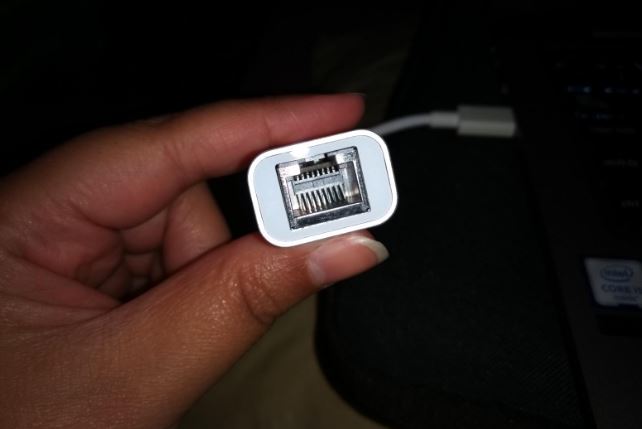
Build Quality
If you’re using the USB-C to Ethernet network adapter with portable use in mind, then you’ll want to pay extra attention to the quality of the build. Making repeated connections with a USB port, carrying and handling the cable, physical strain like that can add-up.
Suppose you accidentally yank the cable, or the end of the connector slides off your desk. The adapter will probably survive, but you may not see the internal strain taken by wiring. Those types of incidents can add up to damage which ultimately renders your adapter unusable.
Another feature that helps out with portability is a reversible design. When you’re trying to connect your stuff together, it’s much easier if you can flip-over and orient the USB-C to Ethernet adapter in whatever way you need to make the connection. The difference is those twelve seconds you spend trying to plug in and adapter. If you’re trying to plug in the adapter to a cramped space behind a computer, or in low-visibility conditions, the reversible design can be majorly convenient.
If you’re not particularly interested in portable use, then your selection is that much easier. But you still should concern yourself with the basic quality of the adapter. A thicker cable tends to indicate a sturdier build, but the specific materials used in construction matter just as much. Are cables wrapped in a soft silicone, protected with ABS plastic, or rolled in PVC?
Compatibility and Capacity
Here’s a big one. Adapters provide different levels of support for different platforms. Many USB-C to Ethernet network adapters claim to provide wide support, but have parts of their feature set missing or reduced in places. Some adapters specialize in just one platform, while others have issues with older operating systems which they’re not keen about disclosing.
You’ll need to look closely at compatibility. This is usually pretty simple if you’re using a common device like a Chromebook or MacBook, but can become a little more difficult if you’re trying to adapt something obscure, like an off brand smartphone.
Anker USB-C Unibody Aluminum Ethernet Port Network Adapter
The Anker USB-C adapter is a relatively simple gigabit Ethernet port to USB-C adapter. It provides wide compatibility for MacBook Pro, Chromebook, and a variety of other platforms. But above all, this adapter has portability written all over it. The extra-short 2-inch cabling allows it to fit inside your pocket about as easily as a disposable lighter.
Build Quality & Specifications
Like the name suggests, the Anker USB-C Unibody Aluminum Portable Adapter is composed of an aluminum body. It feels rather sturdy in your hands without being hefty. The adapter sits at 2.3 x 1 x 0.7-inches, while weighing as little as an ounce.
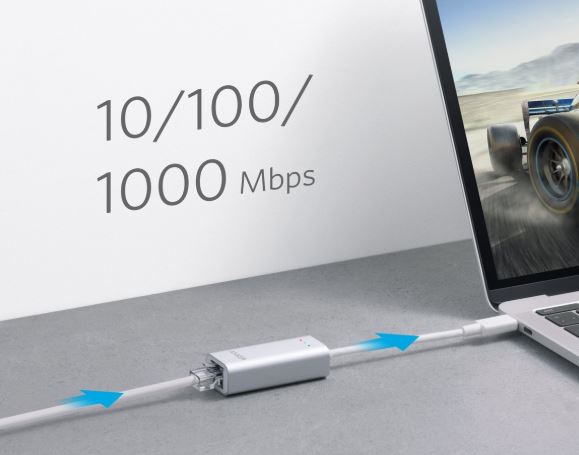
The attached USB-C cable adapter runs about 2-inches past that 2.3” length. The cable is composed of thick white ABS plastic, terminating in a low-profile USB-C connection. It’s sturdy enough to survive some bending, but still is flexible enough to not behave rigidly during storage.
Along the face of the Anker USB-C Unibody Aluminum Adapter, you’ll find three small LEDs. The red light shows power from the USB port. The green light shows a network connection for the Internet. The blue light comes on and off when network activity is occurring. These lights provide a simple way to troubleshoot any problems you might encounter during setup.
Green light goes off? Internet problem. Red light now showing? Try a new USB port, or re-seat the existing connection. You can solve these kind of problems in seconds, and often without having to resort to the Internet for help. Even if you’re not an expert at solving these kinds of problems, you’ll be headed in the right direction, which is more than most adapters can give you.
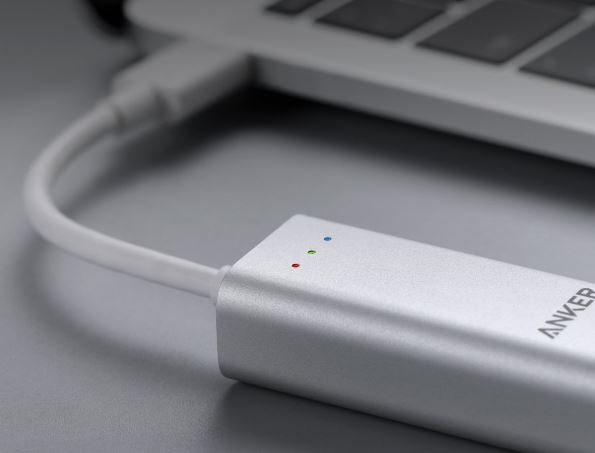
Other Considerations
If you’re using Mac OS, you’ll have to install special drivers to run this adapter. And if you’re running OS 10.13, you can’t get drivers from their Anker site, you’ll need to get a link to Realtek’s site to get the necessary drivers from there. This adds some extra steps to installation.
With several devices attached, this adapter runs somewhat warm, but not so hot that it can’t be touched. The Anker USB-C Unibody adapter provides an 18-month warranty.
AmazonBasics USB 3.1 Type-C to 3 Port USB Hub with Ethernet Adapter
The AmazonBasics USB 3.1 Type-C to USB adapter terminates in three USB ports. It provides the freedom to extend a computer’s Type-C connection into three separate USB-A 3.1 ports, providing network speeds suitable for a Gigabit Ethernet network. And those fast connections are made possible with USB 3.1’s high data bandwidth of 5 Gbps.
Build Quality & Specifications
The AmazonBasics USB 3.1 to Ethernet adapter rests at 3.8 x 1.3 x 0.9-inches. The attached USB-C cabling runs roughly 13” long. That makes this adapter significantly more difficult to shove in your pocket, but without losing too much portability, the lengthy cable does make it better suited to setting up a stationary USB-C to Ethernet hub.
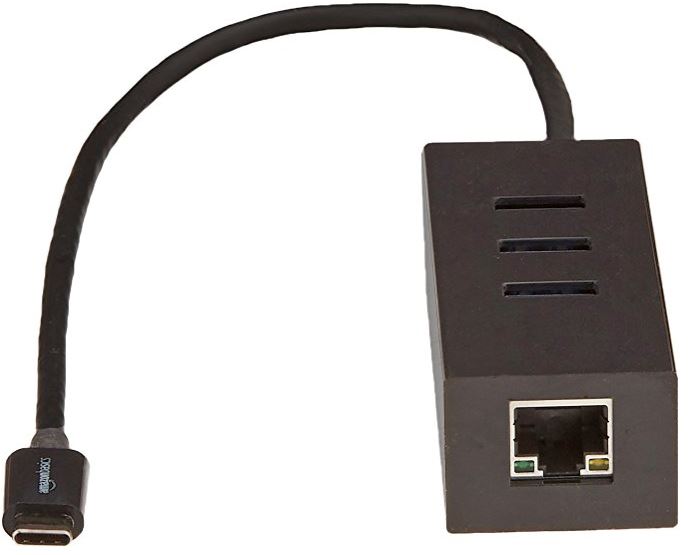
A reversible design of the adapter allows you to switch and flip the cable during installation, so it’s impossible to mess up, and easy to plug things together. AmazonBasics has a habit of offering their PC peripherals in both black and white, and the same is true for this adapter.
Other Considerations
It may be worth noting Ethernet is done over a 1000 BASE-T network, which is a Gigabit network composed of category 5 cabling. It offers backwards compatibility to older network standards, as well. It’s compatible with Chrome OS, Mac OS, and all modern iterations of Windows. For stability, the devices you plug in shouldn’t exceed current of 900mA. The AmazonBasics USB 3.1 to Type-C 3 Port Hub also includes a one-year warranty from AmazonBasics.
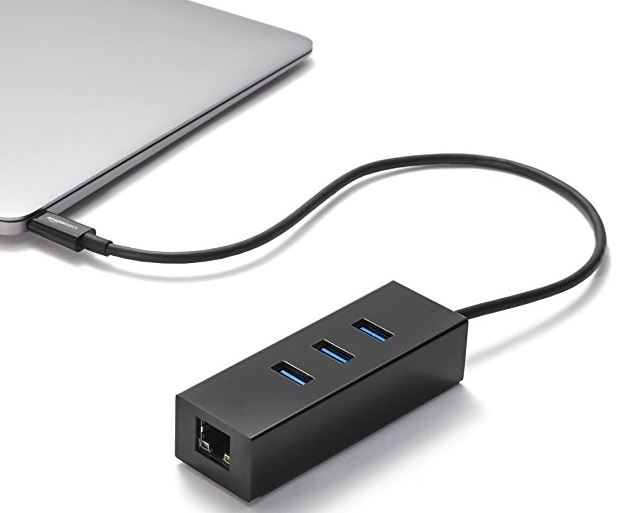
California Proposition 65 warns that the plastics used in the construction of this adapter may be harmful. Unfortunately, Proposition 65 warnings are insanely broad. If you’ve ever been to California, you’ll notice almost everything seems to be covered in these warnings.
That’s because the law makes no distinction between chemicals that will certainly cause horrible cancer and chemicals that, after 70 years, may theoretically increase your risk by one hundredth of one percent. In other words, these warnings are rarely useful. If you find yourself worried, your best course of action is probably to wash your hands after interacting with plastics, and resist whatever urge you may have to put the adapter in your mouth.
StarTech.com USB-C to Gigabit Network Adapter
An Ethernet card isn’t all that portable. But a USB-C adapter? That’s another story entirely. The StarTech USB-C to Gigabit Network Adapter uses a modern USB 3.1 interface, supporting 5Gbps of bandwidth. You can add a GbE connection to your system using USB-C or Thunderbolt 3, and push giant files through gigabit network speeds. And broad Thunderbolt 3 compatibility is no small feat.
Build Quality & Specifications
The StarTech adapter is constructed to a mid-sized 5.6 x 6.7 x 1.2-inch build. Its attached cabling runs roughly 6”, the length of the body. Similar to AmazonBasics, this adapter is available in black and white. StarTech also offers a silver option that’s a shade between the two.
This USB-C to Gigabit adapter doesn’t require you to install special drivers, thanks to its use of the exceptionally common Realtek RTL8153 chipset. And the plug is reversible, which allows you to insert cabling the correct way on your first attempt, without frustration or the risk of damage.

Other Considerations
The StarTech USB-C to Gigabit Network Adapter supports auto-detection for standard 10.100.1000 Mbps networks. If you’re not technologically adept, that added convenience can save you time hassle. And this adapter provides broad support for Windows, Mac, and Chrome OS.
Note, the standard iteration of this adapter includes only the Ethernet and USB-C ports, however, you can also find this adapter with dual Ethernet plugs, or additional USB port hubs. There’s even a version with an added power delivery system, so you don’t have to draw power from your portable devices.
Choosing Between 3 USB-C to Ethernet Network Adapters
AmazonBasics is probably the right choice for most people. The somewhat lengthy 13” cable provides plenty of room for setting up the network adapter, without running the cable so long that it’ll cause any type of bandwidth concerns. And having three hubs to connect from allows this adapter to extend a network to at least three devices. The AmazonBasics adapter is a choice for someone setting up a stationary adapter.
The Anker USB-C Unibody Aluminum Adapter is incredibly small. It fits in a pocket, purse, or just about any type of electronics case. It’s a good choice for someone trying to adapt a single computer’s USB-C port into an Ethernet hub. If your laptop doesn’t have an Ethernet port and you want to plug-in to a network, all you need is this pocket-sized USB-C adapter. It’s the right choice for someone seeking a portable USB-C to Ethernet network adapter for a single PC.
The StarTech adapter is quite-like the Anker USB-C Unibody. Except it’s construction is plastic rather than aluminum, and the size of the hub is somewhat larger. In a head-to-head comparison of the base model, StarTech loses. But what makes this adapter special is your ability to choose between many variants.
There are versions with additional USB hubs, and even a version with a separate power source. That makes StarTech’s adapter the right choice for people who don’t want their USB-C adapter to eat power from their portable devices, or people who want the portability of Anker’s adapter, except with the option to add additional PCs to the network.
Meet Ry, “TechGuru,” a 36-year-old technology enthusiast with a deep passion for tech innovations. With extensive experience, he specializes in gaming hardware and software, and has expertise in gadgets, custom PCs, and audio.
Besides writing about tech and reviewing new products, he enjoys traveling, hiking, and photography. Committed to keeping up with the latest industry trends, he aims to guide readers in making informed tech decisions.

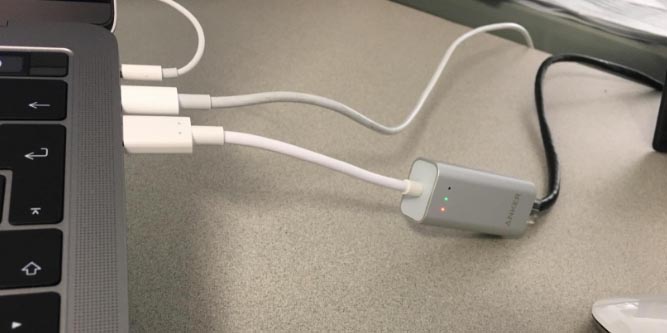
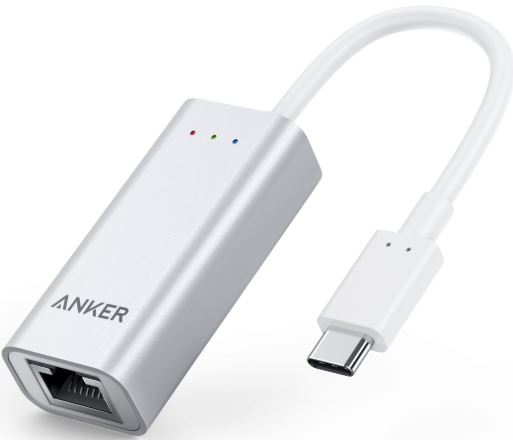
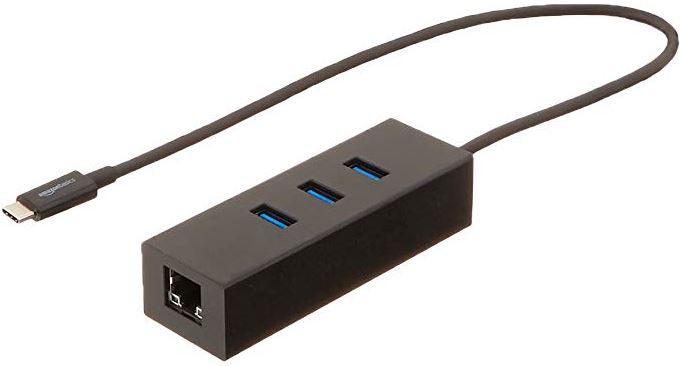
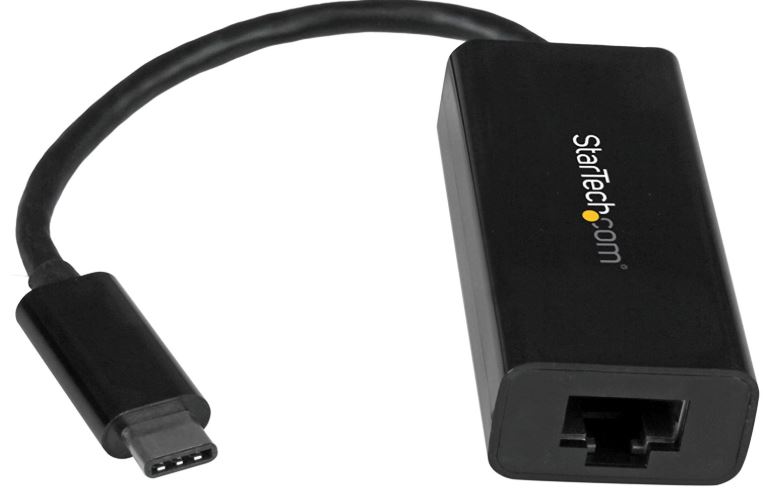
Does StarTech require any driver downloads? I have to use the adapter on various MacBooks at work, so I need something simple but dependable.
Is there an adapter/dongle that can receive a PoE connection via RJ-45 jack, and output both data (ethernet) and power) through a USB-C connection?
There’s no mention of how these USB C to RJ45 adaptors can cope with the ethernet side CAT5 or CAT6 cable runs which may be lengthy. I bought such an adaptor that could deal with a 1 metre cable but when tried with the 30 metre cable no hope. The in built ethernet NIC with RJ45 had no problem with the 30 metre cable run, just in case you were asking.
I bought a RealTech adapter off of amazon for my MacBook Pro. Over wifi in the house I was getting 450 Mbps. Once I connected the adapter, I am getting 900. But I have to run 45 foot ethernet cable from laptop to the modem. The real problem is that the adapter gets SCORCHING hot. Almost too hot to touch. Is this normal? someone suggested going into my MacBook preferences and turning off auto updates, because supposedly the adapter was continually checking for updates. Is this true?